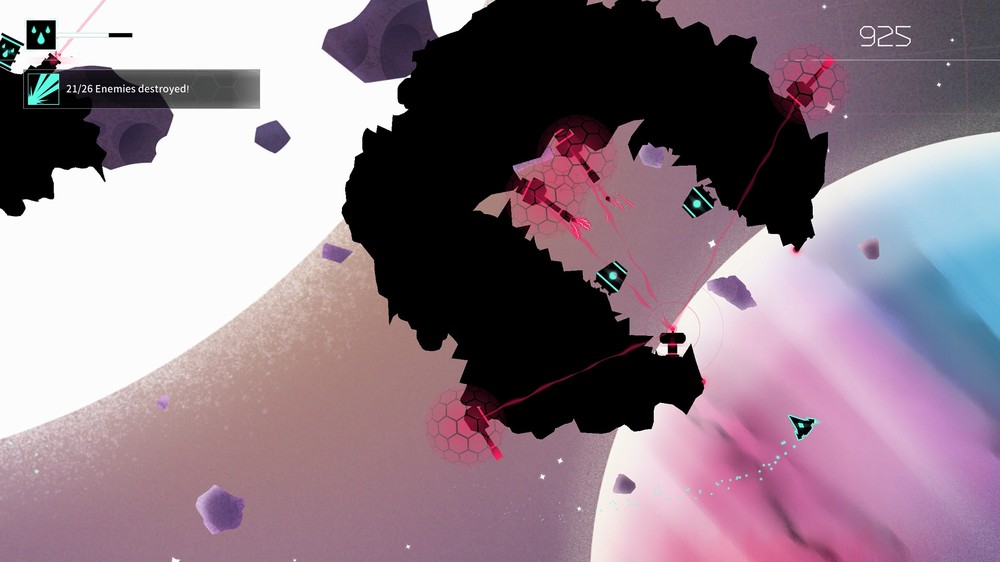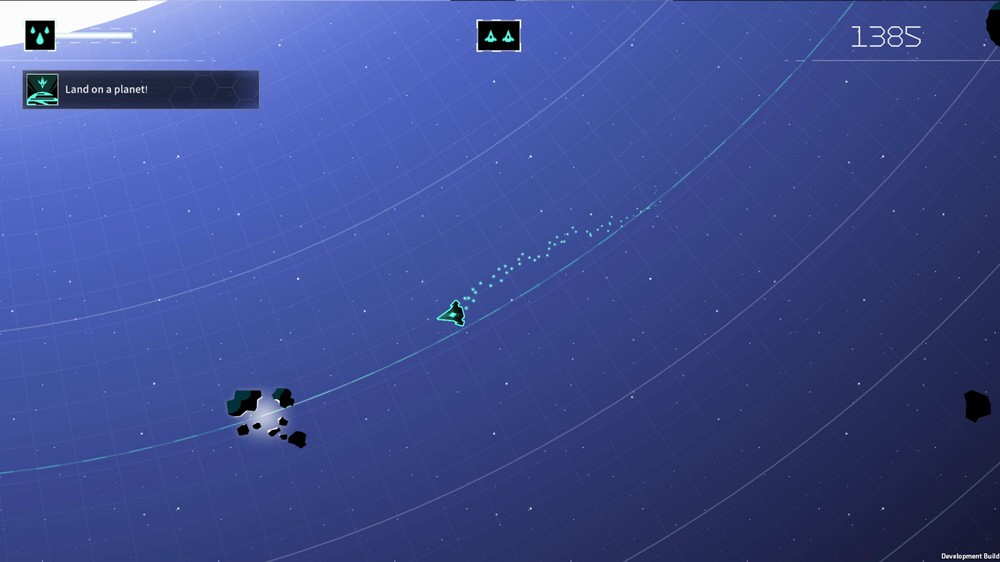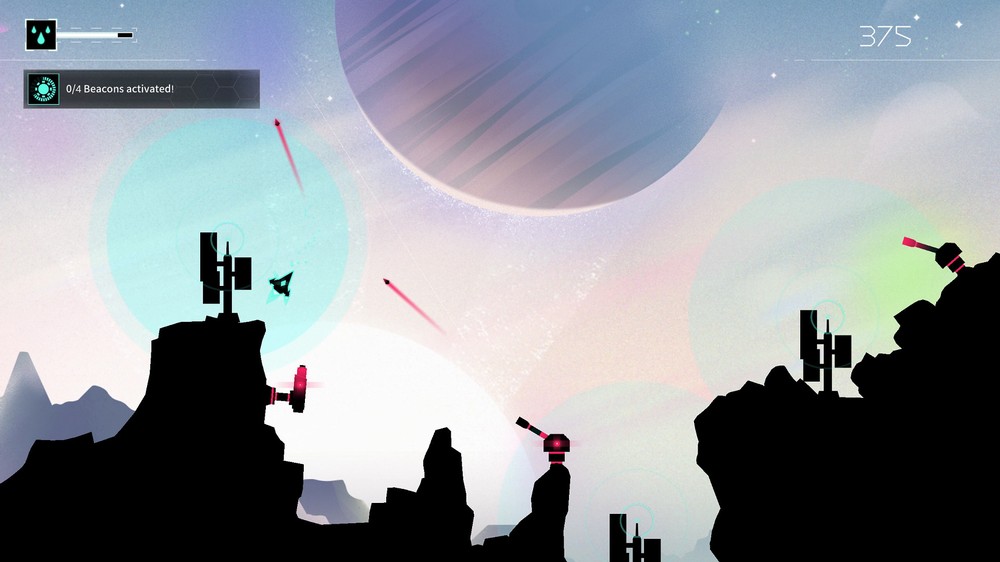Gravitar: Recharged is the fifth arcade remaster I’ve reviewed in the past year, and without a doubt this is easily my favorite of the bunch…so far. I was a huge fan of Lunar Lander back in 1980; a simple black and white physics game where you used thrusters to gently land your spaceship on the jagged surface of the moon before you ran out of fuel. Two years later Gravitar appeared in my campus arcade and tokens literally flew out of my pocket.
 Gravitar took the core gravity component of Lunar Lander and combined it with elements from Asteroids, Space Duel, and other popular games of the time to create this intense arcade game that blended realistic physics with more complex level design, weapons, and more challenging gameplay. I had nearly forgotten the hours of fun I had playing Gravitar back in the 80’s, but it only took a few minutes for those memories to come flooding back.
Gravitar took the core gravity component of Lunar Lander and combined it with elements from Asteroids, Space Duel, and other popular games of the time to create this intense arcade game that blended realistic physics with more complex level design, weapons, and more challenging gameplay. I had nearly forgotten the hours of fun I had playing Gravitar back in the 80’s, but it only took a few minutes for those memories to come flooding back.
Gravitar: Recharged maintains the basic design of the other recharged games by offering an arcade mode along with 24 challenging missions; all of which can be played solo or with a friend in co-op. Co-op mode hasn’t been that big of a deal in previous Recharged games; mostly a way to earn a few achievements, but Gravitar: Recharged mixes things up a bit by tethering your two ships together forcing you to cooperate or die. It’s a really clever mechanic that is totally worth exploring if you have someone to play with.
 This might be one of the first games where you can die in the menu…sort of. When you start a fresh game, you are dropped into a solar system with a sun in the center and six orbital rings, each with a planet, ship, asteroid, or something that you can engage with to trigger the level. All the while the sun is pulling you in so you must maintain opposite thrust to simply survive this “menu” of levels. As each level is completed that ring is removed from the orbital map until you have completed that solar system and you move on to the next.
This might be one of the first games where you can die in the menu…sort of. When you start a fresh game, you are dropped into a solar system with a sun in the center and six orbital rings, each with a planet, ship, asteroid, or something that you can engage with to trigger the level. All the while the sun is pulling you in so you must maintain opposite thrust to simply survive this “menu” of levels. As each level is completed that ring is removed from the orbital map until you have completed that solar system and you move on to the next.
Each mission in the game is varied with certain objectives as well as its own source of gravity, so in one level you might be getting pulled toward the center of the screen while in other levels it could be toward the bottom. No matter which direction, you are constantly compensating for gravity while doing whatever else is required to complete the level. One mission might have you activating beacons, while another will have you destroying a reactor and escaping before the big explosion. You might be required to destroy a certain number of enemies or possibly locate and steal a data card with important intel.
 Gravitar: Recharged does something new with its arcade game in that it gives you modifiers you can toggle to ease the difficulty. Turning these off will obviously shorten your game but boost your score with point bonus modifiers, but turning them on will grant you extra lives, shields, and access to power-ups. Personally, I found I was getting higher scores using these bonuses and I enjoyed the longer play sessions. Without shields one brush with any object or one hit from any enemy is instant death. Interestingly enough, while shields will protect you from enemy fire, the impact of that weapon will knock your ship back in the opposite direction, often forcing you to make some quick corrections to stay alive.
Gravitar: Recharged does something new with its arcade game in that it gives you modifiers you can toggle to ease the difficulty. Turning these off will obviously shorten your game but boost your score with point bonus modifiers, but turning them on will grant you extra lives, shields, and access to power-ups. Personally, I found I was getting higher scores using these bonuses and I enjoyed the longer play sessions. Without shields one brush with any object or one hit from any enemy is instant death. Interestingly enough, while shields will protect you from enemy fire, the impact of that weapon will knock your ship back in the opposite direction, often forcing you to make some quick corrections to stay alive.
As expected, there are numerous weapons and power-ups to collect. You have a tractor beam that can pull items off the surface and into your ship, but it is just as easy to fling that item out into space if you aren’t careful. These items are often stashed near enemy proximity mines which, if detonated, will destroy the collectible, so you need to slip in and snatch the item with your tractor beam without blowing it up. The various weapons are fun and balanced, offering short bursts of superiority, but nothing seems quite as powerful as your basic weapon with a range so far you can kill enemies that aren’t even on the screen.
 Visually, Gravitar: Recharged nothing like its 1982 ancestor. Boasting colorful backgrounds contrasted with mostly black silhouette landscapes, simplistic maze-like structures, and the standard red vs blue enemy color scheme, everything is simple and smartly designed. Clever visual cues like shield energy arcs leading back to their generator make it easy to figure out what needs to be destroyed first. The audio is also fantastic with great sound effects and easily my favorite soundtrack of all the Recharged games to date. Composer Megan McDuffee is on fire with some electronic and techno grooves that I can only compare to the Daft Punk music in TRON Legacy.
Visually, Gravitar: Recharged nothing like its 1982 ancestor. Boasting colorful backgrounds contrasted with mostly black silhouette landscapes, simplistic maze-like structures, and the standard red vs blue enemy color scheme, everything is simple and smartly designed. Clever visual cues like shield energy arcs leading back to their generator make it easy to figure out what needs to be destroyed first. The audio is also fantastic with great sound effects and easily my favorite soundtrack of all the Recharged games to date. Composer Megan McDuffee is on fire with some electronic and techno grooves that I can only compare to the Daft Punk music in TRON Legacy.
Playtime is infinite with Gravitar: Recharged since chasing leaderboards is an endless endeavor. The 24 missions will take more time than you might think; some are incredibly difficult, and then you have that co-op mode taunting you with its own set of leaderboards. The three bonus toggles are a great way to tune the difficulty to your liking. Personally, I found the Shield the most useful perk to activate, as previous Recharged games had already accustomed me to single-life gameplay and the power-ups didn’t seem that game-changing.
 Gravitar: Recharged is easily my favorite of the five Recharged games released so far. It’s hard to imagine I’m having just as much fun with this version of Gravitar as I did 40 years ago in the basement arcade at Purdue University…possibly more fun since playing Gravitar: Recharged on my PS5 isn’t using up all my laundry money. As much as I love Gravitar: Recharged I can’t wait to see what Atari has coming up for their next Recharged installment. Check out this and the other Recharged games on PC and consoles available today.
Gravitar: Recharged is easily my favorite of the five Recharged games released so far. It’s hard to imagine I’m having just as much fun with this version of Gravitar as I did 40 years ago in the basement arcade at Purdue University…possibly more fun since playing Gravitar: Recharged on my PS5 isn’t using up all my laundry money. As much as I love Gravitar: Recharged I can’t wait to see what Atari has coming up for their next Recharged installment. Check out this and the other Recharged games on PC and consoles available today.
If you want to see Gravitar: Recharged in action, check out our first-look video that covers the Arcade mode and several of the missions.










